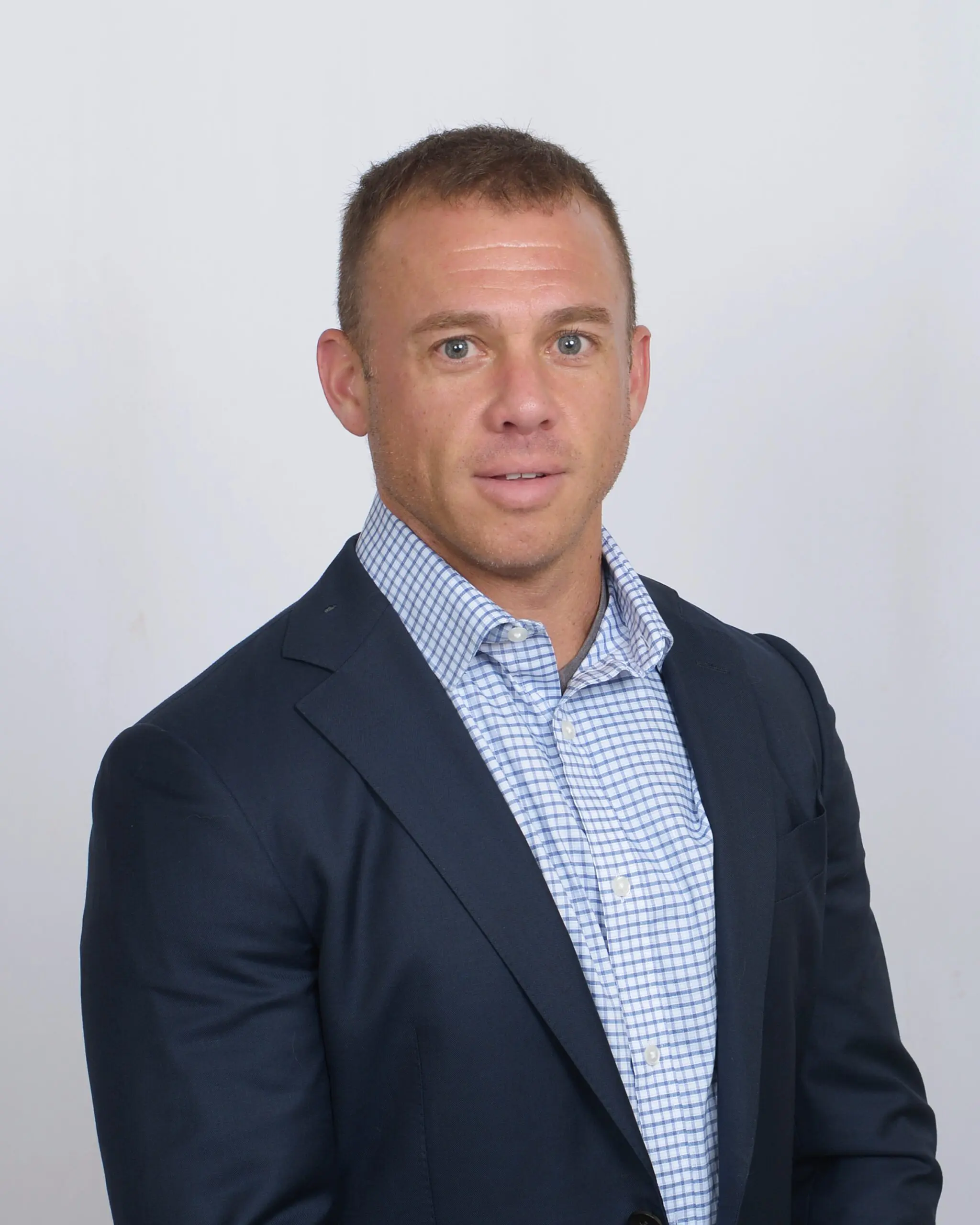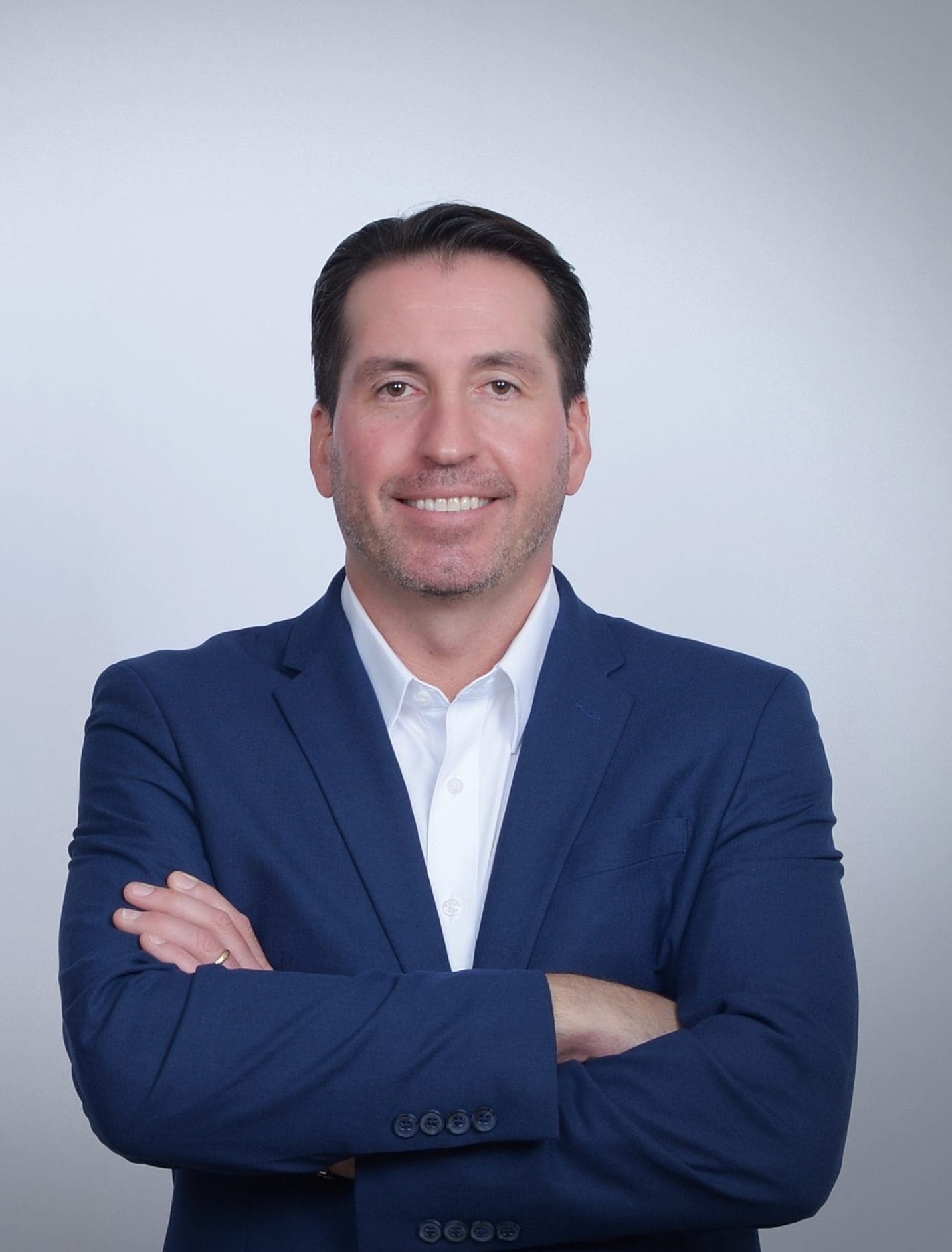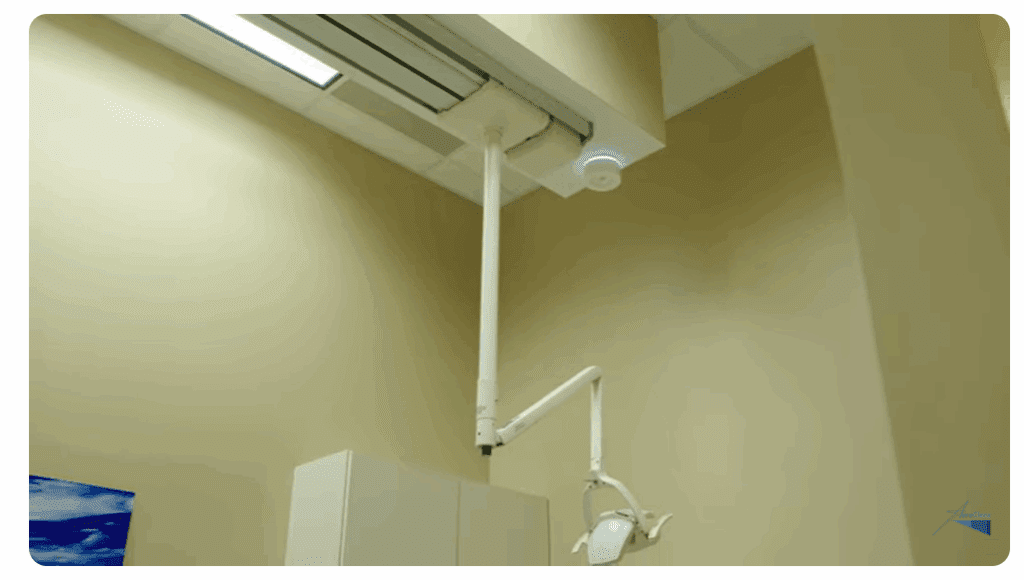
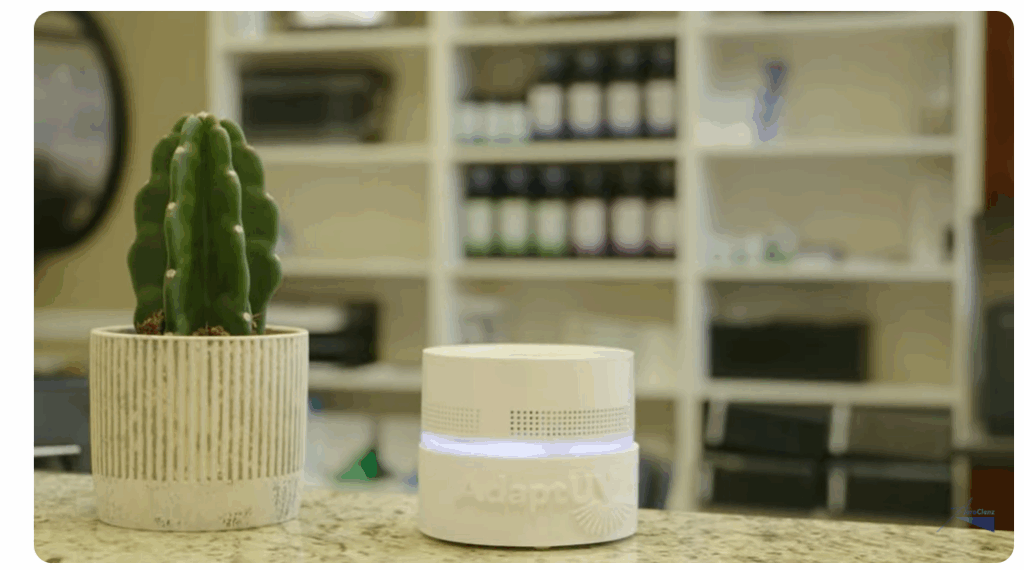
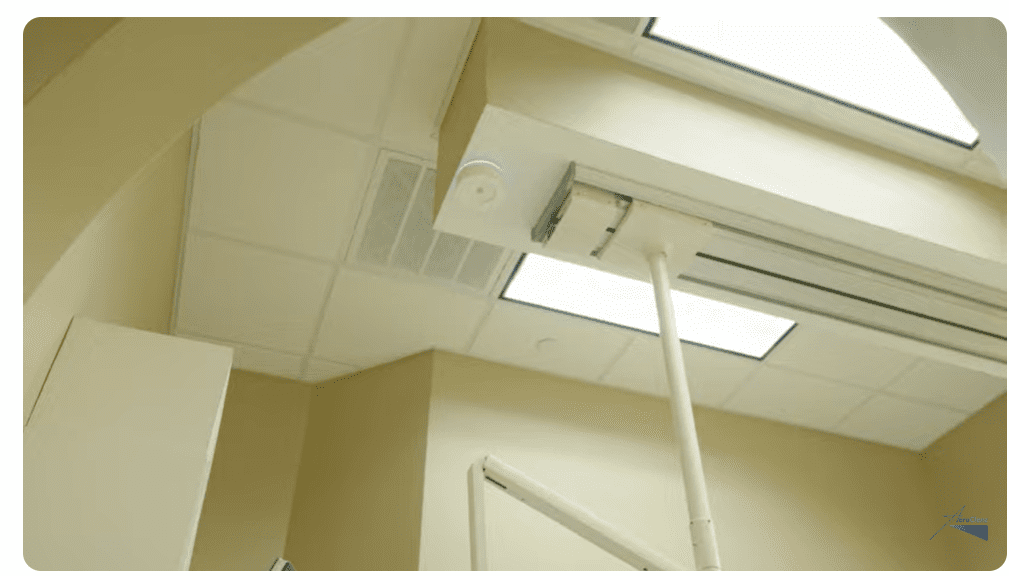
Safety and Effectiveness of New UV-C LED Disinfection Solutions in Dental Offices
D Scott Trettenero DDS
strettener@aol.com
239-878-0172
13440 Parker Commons Blvd Unit 104
Ft Myers Fl 33912
Jacob Andrew Carlton, DMD
Jacob.Carlton@UTSouthwestern.edu
239-850-1995
5323 Harry Hines Blvd.
Dallas, TX 75390-9109
Introduction
Dental practices face unique disinfection challenges. Strict guidelines have been established with requirements for cleaning and disinfection of surfaces, along with barrier protection recommendations.¹ ² The Occupational Safety and Health Administration (OSHA) mandates personal protection gear for staff, which is crucial in protecting against chemical and biological hazards. ³ These requirements are critical for health and safety; however, there is a vital area of concern missing from the disinfection protocols. Recent developments and acknowledgments from the COVID-19 pandemic have demonstrated that respiratory infections are caused by pathogenic aerosols emitted through the nose or mouth.⁴ This is of particular concern to the dental professional as aerosol sprays are produced during many dental procedures. Presently, there are no guidelines for the prevention of these infections by disinfection of the air environment.
Transmission of Respiratory Infections
Infectious diseases caused by the transmission and translocation of airborne pathogens claim millions of lives globally each year. The World Health Organization (WHO) and the US Centers for Disease Control and Prevention (CDC) have officially acknowledged the inhalation of virus-laden aerosols as a main transmission mode in spreading COVID-19.⁵
Many respiratory pathogens, including Severe Acute Respiratory Syndrome, CoronaVirus-2 (SARS-CoV-2) are transmitted via three principal mechanisms. First, inhalation of infectious airborne droplets can occur within a range of one to two meters. Second, touching contaminated surfaces (i.e. Fomites) can allow the pathogen to spread before it decays. Finally, exposure to infected individuals can produce aerosols that linger for minutes to hours and travel further distances via droplets.⁶
Transmission of most airborne pathogens (and especially SARSCoV-2) via contaminated surfaces has been proven to not be the primary path of transmission between people. Instead, the dominant transmission paths are via large airborne droplets, and more typically, by small aerosolized pathogens.⁷
Dentists and their staff are highly at risk from airborne diseases because of the nature of the profession. This starts with the close contact between patients and dental professionals, which increases the opportunities for these airborne transmissions of respiratory pathogens.
The frequent generation of pathogenic aerosols from high-speed handpieces and ultrasonic cleaners contaminate the air and can last for hours.⁸ Also, surface contamination resulting from the aerosols remains a significant concern in dental operatories.
New UVC-LED Disinfection
Fortunately, breakthroughs in UVC-LEDs have created new solutions to air and surface disinfection that have major implications for our health and safety in the dental offices. This technology is also applicable to most all indoor industries where people congregate.⁹
Ultraviolet germicidal irradiation (UVGI) is an established means of disinfection and has been used to prevent the spread of many infectious diseases. UVGI from mercury lamps has been used to disinfect air, water, and surfaces by the disruption of base pair bonds in DNA and RNA so that the strand becomes unavailable for replication. ¹⁰
Earlier methods using ultraviolet (UV) irradiation for decontamination had to rely on high-power low low-pressure Mercury lamps, which, due to their high output, couldn’t be used to directly irradiate the air or surfaces in an occupied space without greatly exceeding the published exposure limits for UV irradiation. Therefore, mercury lamps could only be used in unoccupied spaces, shielded from humans (e.g., at least 7 feet above the floor, or inside the heating, ventilation, and air conditioning (HVAC) ducts). None of these are ideal methods of disinfection.¹¹
More recently, the emergence of low-power UV-C light-emitting diodes (LEDs) have been developed for inactivation of pathogens, especially airborne pathogens, using specific narrow wavelengths.¹² It has been demonstrated that UVC-LEDs can be an effective component of efforts to combat airborne pathogens such as SARS-CoV-2, Influenza A, the common cold, healthcare-acquired bacterial infections, and others.¹³
The UV-C subset of UV radiation between 200 and 280 nm has been employed extensively in germicidal applications. Comprehensive scientific literature exists confirming the applicability, efficacy, and safety of UV-C environmental irradiation. Studies have shown rapid and remarkably high inactivation efficiency for aerosolized pathogens with UVC-LED technology. ¹⁴
Over the UV-C range, the detrimental effect on pathogens occurs because their intracellular components (RNA, DNA, and proteins) can absorb UV-C photons. Absorbed UV-C photons cause critical damage to the genomic system of microorganisms, preventing them from replicating.¹⁵
Ultraviolet light in the traditional UV-C range has photon energies that are nearly resonant with the absorption bands of deoxyribonucleic acid (DNA) and ribonucleic acid (RNA), enabling very effective inactivation of many types of viruses, bacteria, and bacterial spores, as well as fungi and protists.¹⁶
Although viruses have no active metabolic processes that can be interrupted, Ultraviolet-C (UV-C) primarily inactivates pathogens through the creation of dimers in adjacent pyrimidine bases of their nucleic acids, interrupting transcription or translation, thus rendering the pathogens inactivated. Therefore, the effect of UV irradiation on viral
pathogens is called “inactivation” and not “killing”.¹⁷
Far UV-C devices, such as those emitting at a wavelength of 222 nm, have been shown to be effective for disinfection while posing minimal risks to human health. Studies indicate that far UV-C light at 222 nm can inactivate pathogens without penetrating the outer dead-cell layer of human skin and the eyes, thus avoiding significant DNA damage and cytotoxicity. ¹⁸ Over the last several decades, photobiological studies have evaluated the sensitivities of a wide array of bacterial, fungal, and viral organisms to UV. ¹⁹⁻²²
Conclusion
Dental offices now have a scientifically proven and fully researched modality that will offer a new layer of protection to themselves, their staff, and their patients from diseases transmitted by airborne and surface pathogens. UVC-LEDs are much less expensive, compact, more controllable, robust, and proven safe and effective in air and surface disinfection compared to UVGI from mercury bulbs.
These new systems are highly energy-efficient while maintaining peak disinfection performance. The eco-friendly nature of UV-C LEDs ensures that facilities are protected without stringent energy requirements.
Traditional cleaning methods are episodic and susceptible to human error, leaving gaps in protection. New UVC-LEDs can fill those gaps by providing continuous disinfection of both air and surfaces, targeting pathogens close to their source. Combining your standard cleaning routine, this provides an additional disinfection layer and enhances the overall safety of your facility, giving staff and patients enhanced protection from airborne respiratory pathogens as well as surface contaminants in the dental environment.
This patented and proprietary UV-C LED technology is presently being brought to the market through AeroClenz Inc. For more information on this exciting new technology, visit www.AeroClenz.com.
- American Dental Association. Infection Control and Sterilization. Ada.org.
- Centers for Disease Control and Prevention. Summary of Infection Prevention Practices in Dental Settings: Basic Expectations for Safe Care. March 2016.
- Occupational Safety and Health Administration. Dentistry- Standards. Osha.gov.
- Monroe R. It’s Not Just SARS-COV-2: Most Respiratory Viruses Spread by Aerosols.
Scripps Institution of Oceanography. https://scripps. Ucsd.ed/news/its-not-just-sars-cov-
2-most-respiratory-viruses-spread-arerosols. Aug 26, 2021. - Wang CC, et al, Airborne Transmission of Respiratory Viruses. Science. 2021 Aug
27;373 - Morawska L, Johnson G, Ristovski, et al. Size Distribution and Sites of Origin of
Droplets Expelled From Human Respiratory Tract During Expiratory Activities. J Aerosol
Sci 2009; 40:256-69. - Goldman E, Exaggerated Risk of Transmission of COVID-19 by Fomites. Lancet
Infect. Dis., Vol20, Issue 8, p892-893, Aug 2020. - Harrel SK, Molinari J. Aerosols and Splatter in Dentistry: A Brief Review of the
Literature and Infection Control Implications. J Am Dent Assoc. 2004; 135:428-437. - Saito Y, et al. Efficiency Improvement of AlGaN-Based Deep-Ultraviolet Light-Emitting
Diodes and Their Virus Inactivation Application. Japanese Journal of Applied Physics.
Vol 60 Number 8. - Kowalski W. Ultraviolet Germicidal Irradiation Handbook: UVGI for Air and Surface
Disinfection. Berlin, Heidelberg: Springer; 2009. - Kennedy HE. Chapter 62. Ultraviolet Air and Surface Treatment. In: 2019 ASHRAE
Handbook— HVAC Applications. Atlanta: American Society of Heating, Refrigerating
and Air-conditioning Engineers. ASHRAE; 2019:62.1-62.17. - Nicolau T, Gomes Filho N, Padrai J, Zille A. A Comprehensive Analysis of the UVC-
LED’s Applications and Decontamination Capability. Materials (Basel.) 2022 April
13;15(8):2854. - Sheikh J, Swee TT, Saidin S. et al. Classic and Alterative Disinfection Practices for
Preventing of Hospital-Acquired Infections: A systemic Review. Int. J. Enviorn.
Technology. 21, 8261-8296 (2024). - Allen G, Benner K, Bahnfleth W. Inactivation of Pathogens in Air Using Ultraviolet
Direct Irradiation Below Exposure Limits. J Res Natl Inst Stand Technol. 2022; 126 . - Ueki H, Ito M, et al. A 265-Nanometer High-Power Deep-UV Light Rapidly
Inactivates SARS-CoV-2 Aerosols. mSphere Apr 27 2022;7(2). - Walker CM, Ko G. Effect of Ultraviolet Germicidal Irradiation on Viral Aerosols.
Environ Sci Technol. 2007; 41(15):5460–5 - Ma B, Burke-Bevis S, Tiefel L, Rosen J, Feeney B, Linden KG. Reflection of UVC
wavelengths from common materials during surface UV disinfection: Assessment of
human UV exposure and ozone generation. Sci Total Environ. 2023 Apr 15;869:161848.
doi: 10.1016/j.scitotenv.2023.161848. Epub 2023 Jan 26. PMID: 36709900. - Buonanno M, Welch D, Shuryak I, Brenner DJ. Far-UVC light (222 nm) efficiently
and safely inactivates airborne human coronaviruses. Sci Rep. 2020 Jun
24;10(1):10285. - Sun W, Jing Z, Zhao Z, Yin R, Santoro D, Mao T, Lu Z. Dose-Response Behavior of
Pathogens and Surrogate Microorganisms across the Ultraviolet-C Spectrum: Inactivation Efficiencies, Action Spectra, and Mechanisms. Environ Sci Technol. 2023 Jul 25;57(29):10891-10900. - Beck SE, Wright HB, Hargy TM, Larason TC, Linden KG. Action spectra for
validation of pathogen disinfection in medium-pressure ultraviolet (UV) systems. Water
Res. 2015 Mar 1;70:27-37. - Simonet J, Gantzer C. Inactivation of poliovirus 1 and F-specific RNA phages and
degradation of their genomes by UV irradiation at 254 nanometers. Appl Environ
Microbiol. 2006 Dec;72(12):7671-7. - Wen G, Deng X, Wan Q, Xu X, Huang T. Photoreactivation of fungal spores in water
following UV disinfection and their control using UV-based advanced oxidation
processes. Water Res. 2019 Jan 1;148:1-9.
Dr. Trettenero has a private practice in Fort Myers, Florida. A graduate of the University of Missouri at Kansas City in 1980, he has been a solo practitioner for over 40 years. He is the author of two books and many articles published in dental journals and other non-dental publications. He can be reached at (239) 878-0172 or strettener@aol.com.
Disclosure: Dr. Trettenero is a minority shareholder in AeroClenz.
Dr. Carlton is a current Oral and Maxillofacial Surgery resident at Parkland Memorial Hospital and the University of Texas Southwestern Medical Center. He graduated from the University of Florida College of Dentistry in 2021. He attended the University of Florida for an undergraduate, where he majored in Microbiology and Cell Sciences. He may be reached at Jacob.Carlton@UTSouthwestern.edu.
Editor’s note: This article originally appeared in the May 2025 issue of Dental Economics. Reprinted with permission.

